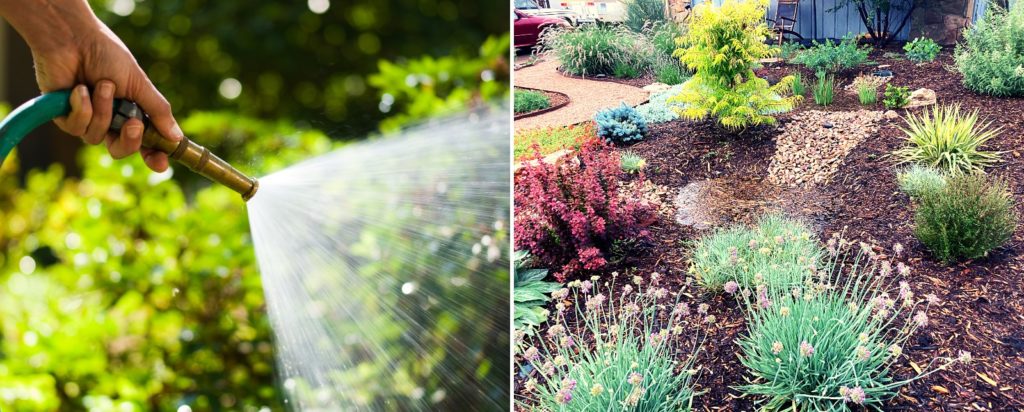14 Jun 5 Simple Ways to Fine Tune your Watering for Drought Resiliency
Drought in our region is the norm, not the exception. With thoughtful planning, it doesn’t have to be a calamity. The crux of the planning revolves around fine-tuning your watering.

1. How you water
- On average we use 5-10 times more water than necessary for a healthy landscape. Talk with your irrigation company about the specific needs of your different plants and areas of your landscape.
- Adjust according to exposure: Fully shaded areas often need up to 30% less water than full sun areas
- Do not use overhead sprinklers in adverse conditions: in hot weather or high winds daytime water use can increase 20-50%, and up to 80% can evaporate
- Protected lower sites need less water than higher and more exposed sites
2. The best time to water is just before sunrise, but after 10 pm is acceptable
- More efficient because of cooler temps, less wind, higher humidity, and higher water pressure
- overlaps with natural dew period decreasing chance of disease
- Saves water and decreases cost
3. Prioritize your watering based on stage of a plant’s life
- While producing flowers and fruit, plants need more water
- New trees and old trees in decline require more water; healthy established trees require less; conifers need more water than deciduous trees
- Young plants – xeric or not – need consistent watering the first 3 years they’re in your landscape
4. Water less frequently and more deeply
- Give the soil a slow long soaking that penetrates deeply into the root zone and below.
- Especially with new plants, this practice encourages roots to go farther down where they can often find their own water, resulting in greater self-sufficiency once established.
- If you do not have irrigation and hand water your plants, put the hose on the ground at a low pressure and set a timer while you go do something else, then move it and repeat.
- This is much more effective than spraying the top of the mulch or soil until it looks wet.
5. The only way to know when to water
- Every site is different, so observing your unique conditions is the best way to get familiar with the soil moisture and plant needs to keep them healthy and thriving.
- A hand check is necessary to see how moist the soil is about 6 inches deep (root zone).
- Use a trowel to gently dig down and touch the soil with your bare fingers at root level. It should feel like a wrung out sponge, neither too dry nor sopping wet.
- If it is dryer than a well wrung out sponge, it is time to water; if it is wetter than than, check again in a day or two.
- Note the amount of water needed will change throughout the season. In the heat of the summer with no rain, every 2-3 days may be necessary, whereas once a week may be sufficient during the cool spring and fall months.
Pro tips
If you do not have irrigation set up and prefer not to water at the crack of dawn, it is worth getting a simple timer at a hardware store inexpensively and connect it to a hose and sprinkler until you can do something more permanent or until plants are established after 3 plus years.
Rain basins also help significantly even when there’s no rain. They provide a depression where water (from hose or sprinkler or rain) can pool, making it easier to deeply hydrate the soil as opposed to running off the surface.
To the Glory of the Garden,
Eva Montane
President of Columbine Landscapes

Sorry, the comment form is closed at this time.